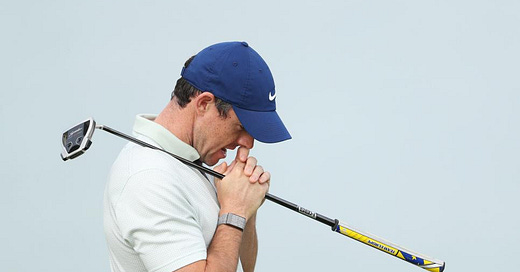The 2nd Cut Newsletter: Edition #28
New Year’s Resolutions, Golf Goals, Consistency, Ben Hogan, Polls and More
“Of all the hazards, fear is the worst.” - Sam Snead
📰 Edition #28 📰
Welcome back to The 2nd Cut Newsletter!
📫 In today’s Newsletter: New Year’s Resolutions, Golf Goals, Consistency, Ben Hogan and More
If you’re new here, this newsletter is designed to provide valuable insights, tips, and ideas from around the internet to improve your golf game.
What you get:
1 - Newsletter every Wednesday
1 - Deep dive every Friday
Sign up below for free to receive the weekly newsletter and deep dive into your email inbox.
🎆 New Year’s Resolutions and Golf Goals 🎆
Welcome back, and Happy New Year! I hope everyone had a great holiday.
On January 1st, many of us came up with our New Year’s Resolutions or goals for the coming year. We’re excited and motivated. The gym is crowded; coworkers are on diets, and friends are budgeting. Unfortunately, many of these well-intentioned goals will be abandoned after a month, maybe two.
As golfers, how can we avoid this and make sure we adhere to and achieve our goals? There’s no guarantee, but there are some tangible, simple things you can do to improve the odds of success.
I’ve talked about Goal Setting before in the aptly titled post Goal Setting. I’ll summarize here:
In the book Mastering Golf’s Mental Game, Dr. Michael Lardon says to improve, we need to build a set of clear goals, both process-oriented and results-oriented. They should be attainable without being too easy.
Goals are important because they form the backbone of a positive feedback loop—one of the most effective tools you can use to stimulate the human brain. If you set clear, specific, productive goals and you improve in a measurable way toward those goals, your motivation to continue to improve increases. The more motivated you get the harder you work—and the more goals you’re able to reach.
1) Write down your goals
Research shows that you are 20 to 40% more likely to achieve your goals when you write them down. That’s a lot.
Why is this? Writing does a few things. Writing forces us to write a clear and articulate goal with no vagueness. However, in your head, it can be vague. Writing also makes you accountable. It’s pen to paper. A reminder to yourself that helps you stay focused and encode said goal.
I use my Apple Notes app so I can refer back to it throughout the year. But do whatever works for you. A planner, a journal, or a sticky note on your desk works fine. Just make sure it’s accessible.
2) Pick Clear, Measurable and Attainable Goals
It’s essential to be clear about your goals. Don’t write down vague goals like “get better at putting.” Be specific and measurable. Instead, write, “Average less than 33 putts per round.”
It’s also important that you pick a reasonably attainable goal. If you make a goal that is too far out of reach, you’ll become discouraged and be more likely to give up.
My advice is to pick a goal within your reach that you would be happy to achieve. Don’t bite off more than you can chew. Remember, once you reach your goal, you can always create a new one! Small wins build up and create momentum.
3) Write Down A Few Process Goals for Each Main Goal
Write down at least 2 or 3 ways to achieve each main goal. For example, if your goal is to break 80, your process goals might be:
Practice 100 yards and in for 20 minutes every range session
Play in 3 competitive rounds
Practice putting 10 minutes 2x per week
Get three lessons with a coach
Studies have found that process goals are more effective than outcome goals. This is because they focus on the how versus the what. Dr. Alex Auerbach says they do this by providing a clear action, anchoring you to the present, and allowing for quick wins.
Think of process goals as the stepping stones toward your main goal. You can adjust them over time.
4) Focus on the Process
Once you set your goals, focus on the process. These are the factors within your control. You can come back occasionally to check on the main goals and ensure you are on track, but it’s a mistake to focus on them after every round.
TLDR
Write Down Your Goals
Pick Clear, Measurable, and Attainable Goals
Write Down A Few Process Goals for Each Main Goal
Focus on the Process
🐦 Tweets of the Week 🐦
This tweet from Ross ties into our New Year’s Resolution intro. Ross is 100% right. Setting goals is great, but they must be somewhat attainable, or you’ll be miserable. You must also focus on the PROCESS and the inputs that lead to your goal. Focusing on the goal itself is counterproductive. Link
Golf will always be inconsistent. It’s inherent to the game. Sometimes, we mistake this inherent inconsistency for something that needs to be fixed. And as Golf Science Lab says, that is usually not the case. Link
Accept the inconsistency and ensure you don’t jump from fix to fix. This is where a coach can really make a difference.
I just started following Kerrod Gray on Twitter, and this short video caught my eye. Arms pulling across my chest and losing structure is a big problem for me. Here’s a drill to help combat that and stay connected. Link
📺 💻 T2C Media 📺 💻
Below is fascinating footage from The 82nd Open Championship at Carnoustie in 1953. Ben Hogan won by 4 in what would be his only Open Championship appearance ever and his 3rd Major win of the season.
Hogan arrived two weeks early to play with the British version of the golf ball, which was slightly smaller.*
Fun Fact* ✔️
Since the early 1900s, the two bodies had agreed that golf balls had to weigh at least 1.62 ounces. But the R&A's rule was that golf balls had to have a diameter of at least 1.62 inches, while in the United States, the USGA ruled in the early 1930s that balls required a minimum diameter of 1.68 inches.
So, in effect, there were two different golf ball sizes around the world: the slightly larger American ball in places governed by the USGA and the slightly smaller British ball in places governed by the R&A.
The smaller British ball flew a bit farther and a bit straighter than the larger American ball. The British ball was illegal under the USGA's rules, but the American ball was legal under R&A rules: The British ball was smaller than the USGA's minimum size, but the American ball was larger than the R&A's minimum.
That meant that when American golfers traveled to an R&A territory for competition — for the British Open, for example — Americans (and everyone else) had a choice of which ball to use. And most American golfers in the British Open chose to forsake the American ball and play with the small ball. Of course, British golfers had that choice all along and, with very few exceptions, chose to play the small ball.
Finally, on Jan. 1, 1990, the rules regarding golf ball size became uniform across the entire golf world when the R&A adopted the 1.68-inch minimum standard.
Source: golfcompendium.com
📊 Poll Question of the Week 📊
I do get the appeal of wanting a great swing, and I’m certainly guilty of it, but not at the cost of my ability to score! Team OK swing, Low Handicap here.
⛳ Thanks for Reading ⛳
Thank you everyone for reading and subscribing. Here’s to a great 2024.
If you have any questions or comments about the newsletter, please comment below or email me at the2ndcut@substack.com. I love hearing from readers.
Til next time.













